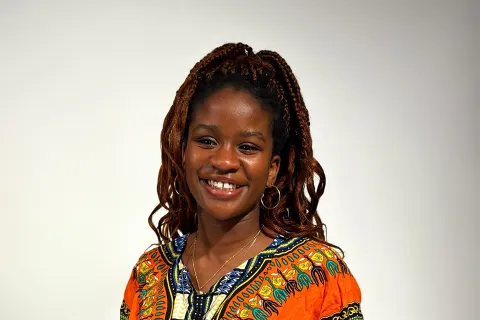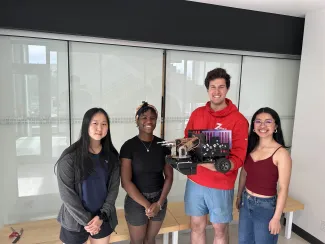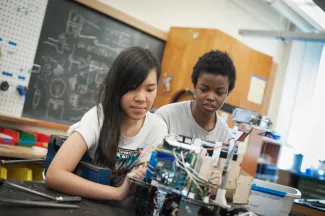"Next, be endlessly curious. University is full of opportunities to explore beyond what’s required in your classes – take them."

Tumi Fabiyi
- Degree:
- Bachelor of Applied Science
- Program:
- Campus: Vancouver
What attracted you to engineering?
Growing up, engineering always felt like a natural fit for me. I’ve always been drawn to math, physics and science, and I love working on hands-on projects where I can see ideas take shape in real life. In high school, for example, I was deeply involved in my school’s robotics team – serving as team captain and founding our first all-girls team. These experiences not only strengthened my technical skills but also taught me the value of leadership, collaboration, and creating opportunities for others to get involved in STEM.
Beyond my interests and skills, I’ve always been drawn to engineering because of the tangible impact it allows you to make on the world. Engineers design and build the tools and systems that shape how people interact with the world, and they can embed their philosophies and values directly into that work. The ability to take an idea from a sketch in a notebook to a fully functioning prototype is incredibly powerful. What ultimately drew me to engineering is that it gives me the opportunity to not only create and problem-solve but also to infuse my values into my work and make a meaningful difference – to literally help shape a world that reflects the principles I care about.
Why did you choose Engineering Physics?
I’d never even heard of Engineering Physics before first year – I had fully expected to go into computer engineering to pursue my interests in robotics.
However, during my first year, I realized that Engineering Physics combines everything I love: the theoretical foundations of math and physics alongside the hands-on aspects of electrical, mechanical and software engineering.
I was also attracted to its rigorous curriculum and the program’s impressive alumni, who have gone on to lead across a wide range of industries. Best of all, it turned out to be much more aligned with my robotics interests than I had anticipated, offering an intensive robotics and prototyping course in the summer of my second year.
I’ve just finished my second year, which was a busy but rewarding one! In addition to a heavy course load, I was involved in numerous extracurricular activities and held a part-time job, which allowed me to apply what I was learning in real-world contexts while developing valuable skills outside the classroom.
Tell us about your co-op position.
I completed a four-month co-op term at Insporos from January to April 2025. The startup company is developing technology to sort out non-viable seeds before they are planted. As a research and development intern, I worked on optimizing the seed scanner as well as developing an imaging system.
This was an interesting experience. I’d worked the summer before at Amazon, focusing entirely on software development, whereas this role brought in mechanical and electrical engineering, as well as project design. My time at Insporos was a more holistic engineering experience.
Why do you think it’s important to get involved in these types of activities?
I see a lot of value in getting involved in clubs and groups, particularly those that aren’t focused on engineering. I believe this involvement is essential because, to be an effective engineer, you need a diverse range of perspectives and experiences to inform your design practice.
Engaging in these activities exposes you to these perspectives and deepens your understanding of how engineers fit into a broader society.
Despite being central to the design process, values are often overlooked. Everything we make is infused with our values and beliefs, and we’ve seen how embedding values like extraction, convenience and hyper-efficiency into our designs – while useful in some aspects – can lead to a world that is lonelier, more hostile and less sustainable. To avoid these outcomes, one must consider how their design will exist in the world and be used by people of varying backgrounds, experiences and abilities. For me, getting involved and taking a values-based approach to design is a key step toward becoming the kind of engineer who works to build a more inclusive and healthier world
What goals do you have for yourself for the remainder of your degree?
There’s so much to do! I’d like to go on exchange, do more co-op terms, take the new venture design course and join a design team again. Not to mention the leadership positions I’d like to continue with. Overall, I want to make the most of my experience at UBC, following wherever my curiosity takes me, and being a leader in every space I enter!






